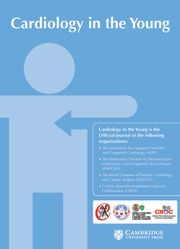No CrossRef data available.
Article contents
Impact of growth on electrophysiological properties of ventricular pre-excitation in paediatric athletes
Published online by Cambridge University Press: 21 November 2024
Abstract
Risk stratification is recommended for patients with ventricular pre-excitation, particularly when sports eligibility is required. Few studies have examined the changes in the electrophysiological properties of the accessory pathway during growth. This study investigates the evolution of electrophysiological properties of the ventricular pre-excitation in young athletes referred for sports eligibility.
Between January 2011 and July 2022, 44 paediatric patients (32 males; mean age, 10 ± 2.42) with ventricular pre-excitation underwent an electrophysiological study, both at rest and during adrenergic stress at two different times (T0 and T1) within a minimal interval of 2 years. Transcatheter ablation was not performed between the two electrophysiological studies. Electrophysiological data were collected and compared.
Electrophysiological study under basal conditions showed a significant decrease in the anterograde accessory pathway effective refractory period and 1:1 conduction over the accessory pathway from T0 to T1. The shortest pre-excited R-R interval during atrial fibrillation did not significantly change at the basal condition; however, it decreased during the stress test. Furthermore, six patients (13.6%) changed the risk profile of their accessory pathway: two “high-risk” patients at T0 became “low-risk” and four “low-risk” patients became “high-risk” at T1. Atrioventricular re-entry tachycardia inducibility did not differ significantly between the two electrophysiological studies.
This study highlights the importance of repeating electrophysiological study (transesophageal or intracardiac) in paediatric athletes with ventricular pre-excitation because significant and clinically relevant changes in the conduction and refractoriness of accessory pathway can occur. This could influence risk stratification for sports eligibility and the correct indication and timing for accessory pathway ablation.
Keywords
- Type
- Original Article
- Information
- Copyright
- © The Author(s), 2024. Published by Cambridge University Press



